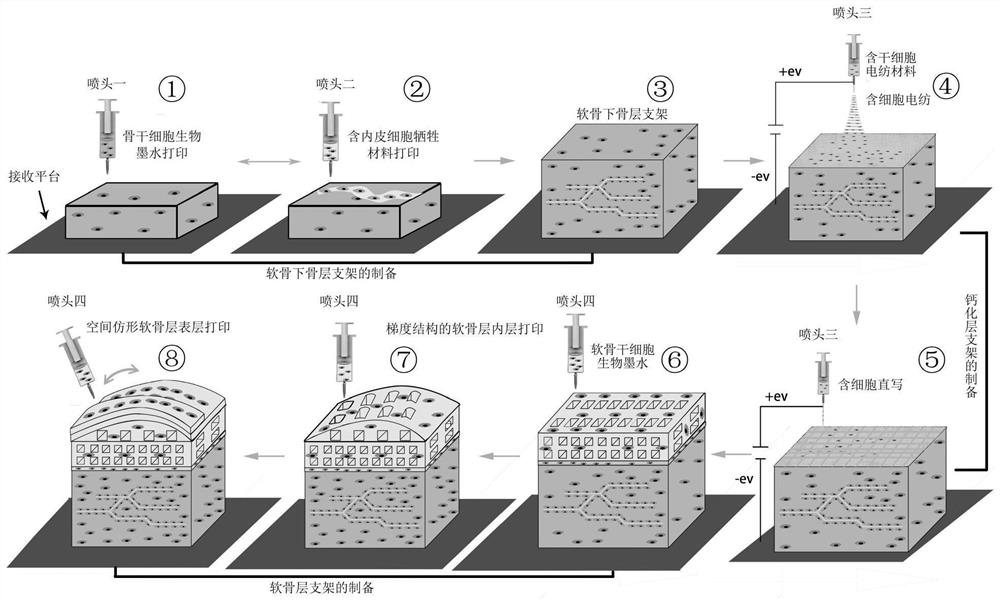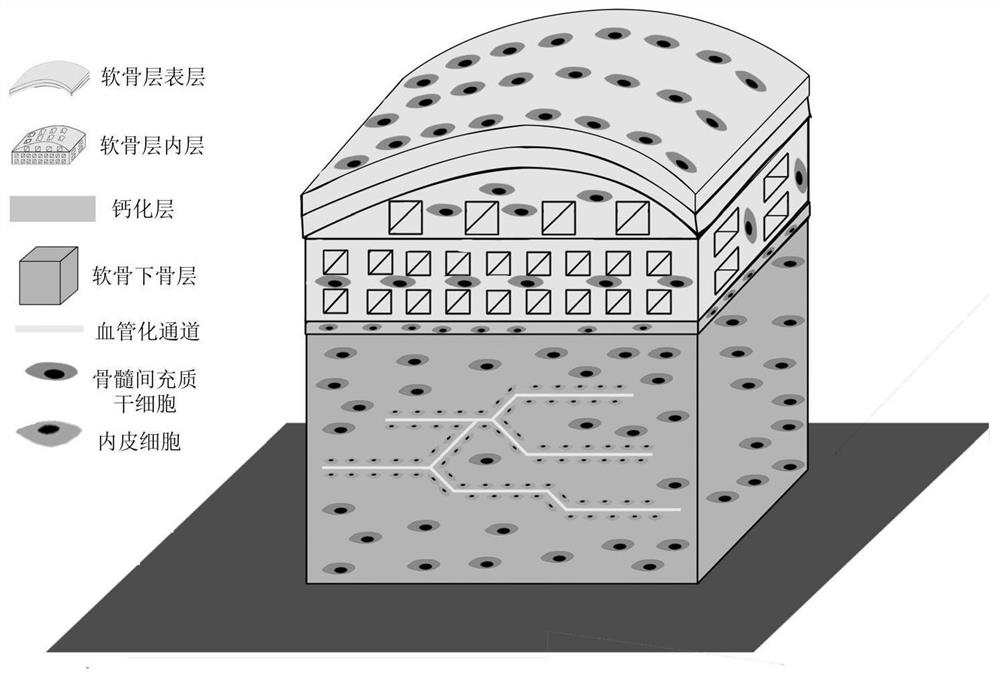A biomimetic cell-containing bulk osteochondral bioscaffold and preparation method thereof
A bio-scaffold and osteochondral technology, applied in the field of biomedical tissue engineering, can solve the problems of surrounding tissue fit, singleness, support, vascular network channels and cell-induced differentiation, so as to speed up repair and promote integrated repair and reconstruction. Effect
- Summary
- Abstract
- Description
- Claims
- Application Information
AI Technical Summary
Problems solved by technology
Method used
Image
Examples
preparation example Construction
[0031] The invention provides a method for preparing a biomimetic cell-containing bulk osteochondral biological scaffold, comprising the following steps:
[0032] The subchondral bone material containing bone marrow mesenchymal stem cells is subjected to the first extrusion 3D printing, and the sacrificial material containing human umbilical vein endothelial cells is used for the second extrusion 3D printing in the formed subchondral bone scaffold structure, alternately in turn. performing the first extrusion 3D printing and the second extrusion 3D printing to obtain a subchondral bone layer containing a prefabricated vascularized network structure;
[0033] Using electrospinning material containing bone marrow mesenchymal stem cells, electrospinning is performed on the subchondral bone layer, and a cell-containing nanofiber isolation membrane is formed on the upper surface of the subchondral bone layer;
[0034] Continue to use the electrospinning material containing the bone...
Embodiment 1
[0077] according to figure 1 The flow shown carries out the scheme of embodiment 1:
[0078] a. Preparation of bone stem cell bioink: using PBS buffer as solvent, gelatin (10%), sodium alginate (5%), bone marrow mesenchymal stem cells (5×10 6 cells / g) were mixed and prepared, and BMP-2 protein 5% (w / w, relative to the total mass of the bone stem cell bioink) was added; 10 mL of the prepared bone stem cell bioink was added to a medical syringe, and the syringe Installed on the first print nozzle;
[0079] Preparation of cell sacrificial material: PBS buffer was used as a solvent, and collagen (5%, w / v), PVA (10%, w / v) and human umbilical vein endothelial cells (5×10 6 cells / g) mixed and prepared; then add 10 mL of the prepared cell-containing sacrificial material into a medical syringe, and install it on the second printing nozzle;
[0080] b. Preparation of electrospinning materials containing stem cells: using PBS buffer as solvent, PEO (15%), sodium alginate (5%) and huma...
Embodiment 2
[0088] The difference between this embodiment and Embodiment 1 is only:
[0089] Bone stem cell bioink, the solvent is HBSS solution (Hank's balanced salt solution), using methacrylated gelatin (12% w / v), hydroxyapatite (5% w / w) and bone marrow mesenchymal stem cells (5% w / w) ×10 6 cells / g) were prepared by mixing and adding LAP photoinitiator 0.2% (w / w, relative to the total mass of the bone stem cell bioink);
[0090] The cartilage stem cell bioink solvent is HBSS solution (Hank's balanced salt solution), using methacrylated gelatin (10% w / v), hyaluronic acid (10% w / v) and bone marrow mesenchymal stem cells (5 × 10 6 cells / g) were prepared by mixing and adding LAP photoinitiator 0.2% (w / w, relative to the total mass of the cartilage stem cell bioink);
[0091] The prepared bulk osteochondral scaffold was placed under blue light with a wavelength of 405 nm for cross-linking;
[0092] Other steps are the same as in Example 1.
PUM
| Property | Measurement | Unit |
|---|---|---|
| diameter | aaaaa | aaaaa |
| diameter | aaaaa | aaaaa |
| porosity | aaaaa | aaaaa |
Abstract
Description
Claims
Application Information
 Login to View More
Login to View More - R&D
- Intellectual Property
- Life Sciences
- Materials
- Tech Scout
- Unparalleled Data Quality
- Higher Quality Content
- 60% Fewer Hallucinations
Browse by: Latest US Patents, China's latest patents, Technical Efficacy Thesaurus, Application Domain, Technology Topic, Popular Technical Reports.
© 2025 PatSnap. All rights reserved.Legal|Privacy policy|Modern Slavery Act Transparency Statement|Sitemap|About US| Contact US: help@patsnap.com


